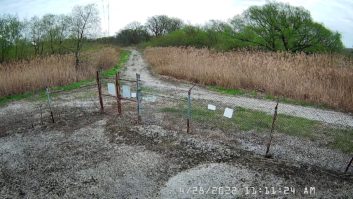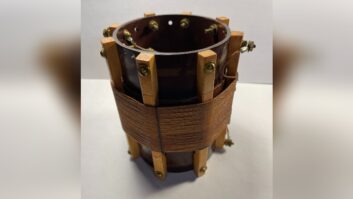At least once in your engineering career, move a transmitter.
Not you personally, mind you. But the project is an experience an engineer should enjoy. Here are some tips.
When you buy a rig, the moving issue usually is determined by the manufacturer. Make sure you specify inside delivery.
Another consideration is entry to the building. If you’re designing a transmitter building, you will never regret indulging in the luxury of oversized or double doors.
If you don’t have double doors, measure the door width and height, then compare that to the palleted transmitter. Most new transmitters arrive on a wooden pallet. Remember that wooden pallets are not created equal; verify the height from your manufacturer. The object here is to have no surprises on moving day.
One of my associates recalls a transmitter delivered by a company that didn’t do “inside deliveries.” Its truck couldn’t make it down the road to the transmitter building, and the driver had other runs to make.
So the driver simply dropped the transmitter by the side of the road.
When the engineer got back with some additional muscle and a lift-gate truck, there sat his pretty new transmitter ,owning the curb. Fortunately, this was a rural area; no one had bothered the transmitter. It was covered with plastic, so the transmitter was protected from the rain. Still, not the greatest experience.
(click thumbnail)Fig. 1: Double or oversize doors provide easy access for transmitters.
(click thumbnail)Fig. 2: Measure door and hall entries before the transmitter arrives.
(click thumbnail)Fig. 3: What’s hiding here?
(click thumbnail)Fig. 4: An inner tube protects locks against freezing.
During my time at Harris, I was at a customer’s site as he took delivery of his new transmitter. Most deliveries took place without a hitch; in this case, the driver was late, and it was nearly dark as he backed the truck up to the building and lowered the lift gate. He wanted to make sure the truck was in position so that the gate would be level with the door threshold.
Everything was perfect, so he pulled on the lever to lift the gate. Nothing happened.
A half hour of futzing with the mechanism; still nothing. It was really getting dark.
The driver decided to drive back to the truck depot and transfer the transmitter to another truck. He tried to pull forward and the gate dragged on the ground. No luck, he’s stuck.
All he could do was put the truck in reverse and line back up with the building. It was getting cold, and the driver couldn’t reach anyone at the depot.
Someone got the idea of a broken wire, so there we were, flashlights in hand, under a truck on the cold ground, troubleshooting the lift gate circuit. It turned out to be a broken wire, located behind the hydraulic pump.
The transmitter got off-loaded; and although everyone was cold and tired, the story ended on a positive note.
I relate this to show that even new transmitter deliveries can have their problems.




. . .
So what do you do if it’s up to you to plan a transmitter move?
First, consider your liability. Yes, some of the newer solid-state AM rigs can be walked into place by a single person; but should that person be you? If you’re a contract engineer and you don’t have insurance, and you drop or damage the transmitter, you could find yourself on the receiving end of a lawsuit. If you’re an employee, there may be OSHA rules to consider.
Foremost, put your safety ahead of saving your employer or contract client money. As engineers, we sometimes feel we can do most anything; the question is whether it’s in our best interest.
So you’ve just gotten a quote from a rigging company for ten grand to move the behemoth. What are your options? There’s the vending machine company we told you about in a previous column.
Mike Pappas, the chief for KUVO Public Radio, in Denver, offers another suggestion. Mike uses Student Movers to move transmitters. They are bonded and insured. The company uses lift gate trucks (that work, I might add). They are reliable and offer reasonable prices.
Mike writes that he has a difficult site for shuttling transmitters in and out. The transmitter must be carried in on its back, then lifted over the corner of a genset. Student Movers handled this without breaking a sweat – or the transmitter – at a reasonable price. Mike can be contacted at [email protected].
Mike signs his e-mails with the KUVO Engineering Department motto. For engineers, it says it all: “Never have so few done so much with so little for so many.”
It never hurts to toot your own horn.
. . .
What’s hiding behind the black curtain, shown in Fig. 1? Read on for the answer later.
. . .
Alan Peterson found an interesting discovery at Radio America in Washington while installing a new Symetrix AirTools 6100 obscenity delay.
This delay box has the ability to readjust ESE time clock displays to reflect the time of day adjusted for the delay time; for example, real time could be 11:59:50, but if the box is set for a 10-second delay, it automatically compensates the clock display to show 12:00:00. This means the talent and producer do not need to do math in their heads to figure out the exit time for a program.
Along the way, they discovered the importance of what flavor of time code drives the house. The AirTools likes to see TC 89 code, a standard code generated by ESE clocks. Radio America is driven by TC 90, a slightly different code with the addition of the date. Changing the code at the GPS receiver to TC 89 made the delay box and rack clock display happy, except it stalled out the clock built into the Wheatstone A6000 console.
Changing one jumper on the Torpey Time CPU7 clock module (OEMed for Wheatstone by Torpey Time) got the clock in step with the rest of the house.
Look for jumpers and alternative means of time code in your studios should you run into these compatibility issues. Early in the studio planning, be sure to ask manufacturers if you will need a time-code converter.
Thanks, Alan, for the solution to this problem. Reach Al at [email protected].
. . .
Did you guess what was behind the cover in Fig. 1?
Engineers in colder climes would spot the lock protector right away. The flap of tire inner tube keeps snow and ice from building up on locks. It is located on an AM tuning unit fence. This idea can be adapted with a short piece of metal stock and bolted onto galvanized fences as well.
It’s not too early to prepare for winter. Protect your locks and save the frustration of thawing frozen hardware by installing these simple protectors.
Submissions for this column are encouraged, and qualify for SBE recertification credit.












